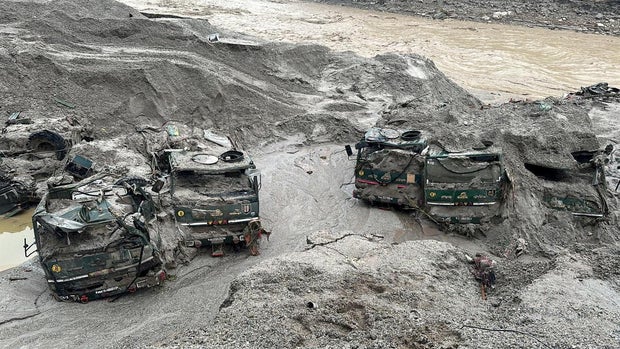New Delhi — The death toll from devastating flash floods unleashed by a glacial lake bursting its banks in India’s ecologically sensitive Himalayan region shot up to 40 on Friday, government officials said. The Lhonak Lake in India’s mountainous state of Sikkim bust through a dam Wednesday after a cloudburst triggered rains and an avalanche, causing major flooding in the Teesta river.
The floodwater caused massive devastation, washing away or submerging 15 bridges and dozens of roads, cutting off significant sections of the small state in India’s far northeast, which is surrounded on three sides by China, Nepal and Bhutan. The only highway connecting the state to the rest of India was damaged, making relief and rescue work challenging.
The death toll could rise further as more than 70 people, including 23 Indian Army soldiers, were still missing on Friday.
India Army/Handout/REUTERS
At least 22 bodies were been found hundreds of miles downstream in the Teesta, in Sikkim’s neighboring state of Bengal, and a few bodies were retrieved from the river as far away as Bangladesh, according to the Times of India.
The Indian Army, which suffered massive damage to its camps in Sikkim, pressed its teams into rescue and relief work. The army was planning to use helicopters to evacuate nearly 1,500 stranded tourists as the weather improved.
The state government said the disaster had impacted the lives of 22,000 people.
Scientists have warned of such disasters for decades
The flooding was one of the worst disasters to date in India’s fragile Himalayan region, but it was the latest in a series catastrophes linked to extreme weather events blamed by scientists on climate change.
Prakash Adhikari/AP
Last year, severe flooding in Sikkim killed at least 24 people and displaced tens of thousands. In 2021, a tragedy similar to Wednesday’s in another Indian Himalayan state, Uttarakhand, left dozens dead when a glacial lake burst its banks.
Scientists have warned about the melting of Himalayan glaciers for decades, saying the pace at which they’re losing ice is a threat to the whole world, not just Asia.
But experts warned about the possibility of Lhonak Lake bursting specifically in 2021, when a study highlighted the increasing length of the lake and cautioned that it was sensitive to extreme weather events such as cloudbursts.
“It was already predicted in 2021 that this lake would breach and impact the dam,” Dr. Farooq Azam, a glaciologist at the Indian Institute of Technology Indore, told CBS News on Friday. “There has been a substantial increase in the number of glacial lakes as the glaciers are melting due to global warming.”
In fact, scientists had warned there was a very high probability of a sudden outburst of Lhonak Lake in 2013, and again in 2001.
Earth’s average surface temperature has risen about 2 degrees Fahrenheit since pre-industrial times, but the world’s high-mountain regions have warmed at twice that pace, climate scientists say.
XAVIER GALIANA/AFP/Getty
Researchers say snow cover, glaciers and permafrost will continue melting in almost all global regions throughout the 21st century. There’s also high confidence among scientists that the number of and the area covered by glacial lakes will continue to increase in most regions in the coming decades, with new lakes developing closer to steep, potentially unstable mountains, where landslides can trigger lake outbursts.
“There are more than 54,000 glaciers across the Hindu Kush Himalayan region and very few of them are monitored, which means that such disasters will continue to increase,” a climate scientist and lead researcher with the United Nation’s Intergovernmental Panel on Climate Change (IPCC), previously told CBS News.

















































